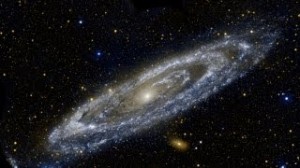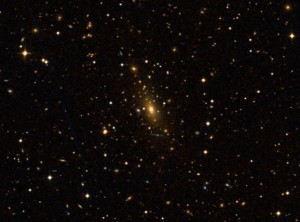The Largest Galaxy in the Universe: IC 1101
And you thought Felix Baumgartner’s stratospheric leap made you feel small.
We’re discovering incredible facts about the universe seemingly everyday. We think the universe is 13.7 billions years old and it is currently expanding. There are theories that the universe could be infinite, and theories that there could be multiple universes. For our purposes today, we’re going to stick with just the facts, and talk a little bit about the largest galaxy known to man, the creatively named IC 1101!
The Milky Way Galaxy
The galaxy in which Earth resides, the Milky Way galaxy, is about 100,000 light years in diameter. You may be asking yourself, what is a light year? How many miles are there in a light year? You’d probably be surprised to learn that just one light year is equivalent to 5.9 Trillion miles! (Actually it’s 5,865,696,000,000, but who’s counting).
To put this into the perspective of our space travel capabilities, NASA’s Voyager 1 probe, the farthest object ever launched from Earth, has currently traveled a cumulative 11.3 billion miles. Did I mention that Voyager 1 departed from Earth 35 years ago?
IC 1101
Now that we’ve come to grips with the unfortunate fact that we’ll probably never get to visit IC 1101, let’s figure out just how big it is compared to the seemingly massive galaxy we live in. We said that the Milky Way was 100k light years in diameter, well IC 1101 is about 5.5 million light years in diameter! It’s also located over one billion light years away from Earth! It’s so mind blowingly huge and far away that your brain may have just exploded (if so, we apologize). Chances are you’ve never thought about space quite like this.
Just how did IC 1101 become the biggest galaxy in the universe? Over billions of years, smaller galaxies became attracted to one another and collided. This process, though long and arduous, creates an exponentially larger galaxy, refreshing it with new materials and stars in the process. Pretty crazy stuff.
Star Power
Finally, as you probably already know, the thing that we call our sun is a star. There are between 100-200 billion stars in the Milky Way Galaxy. How many stars are there in IC 1101? Try 100 trillion.
Yep, we’re pretty tiny in the grand scheme of things. We’re making some sensational scientific and technological breakthroughs everyday, and we can definitely reach for the stars, but we’ve still got a long way to go before we can get to these stars. Here’s a short video talking more about IC 1101.
Comments
Tags: biggest galaxy, how many miles in a light year, how many stars are there, ic 1001, largest galaxy in the universe, miles in a light year, milky way galaxy, stars in the milky way, what is a light year
Trackback from your site.



Comments (5)
Trekkie
| #
Hmmm, now I want to know about the Voyager, is it still traveling through space? Did you mean it’s trip began 35 years ago and is still traveling? If that is the case, what is powering it a beryllium sphere perhaps? You can tell me “mum’s the word”, “mum, mum”
Reply
Mike Awada
| #
Mum is the word Captain Nesmith, but yes, the Voyager took off from Earth 35 years ago and is now just heading away from the sun and out of our galaxy.
We continue to monitor readings from the Voyagers nearly everyday, and have noticed a change in the ratio of low energy to high energy particles, indicating a change in the space around them.
You can read a brief history on the two Voyagers, a combined 20 billion miles away, right here: http://voyager.jpl.nasa.gov/news/voyager_35.html.
Reply
IC 1101, a maior galáxia do universo | Mistérios do Mundo
| #
[...] é um importante objeto de estudo para se resolver o mistério da matéria escura. [Chandra, Astounde] /* TweetTags:astronomia, galáxias Seguir @misteriomundo!function(d,s,id){var [...]
Reply
Perto da maior galáxia já encontrada a nossa Via Láctea é um grão de areia - Noticias em tempo real
| #
[...] A matéria escura fria recebeu o seu nome a partir da suposição de que suas partículas estavam se movendo lentamente quando galáxias e aglomerados de galáxias começaram a se formar. A natureza exata dessas partículas é ainda desconhecida.[Chandra, XMM, Astounde] [...]
Reply
clint
| #
Your paragraph that covered IC 1101 has a slight typo. Second sentence you state that the Milky Way Galaxy is 100k miles in diameter. I do believe you meant to say 100k light-years in diameter. Which is larger on the scale of trillions times bigger than 100k miles. Comparing a light-year to a mile is like comparing a mile to a nanometer, if my math is correct.
Reply